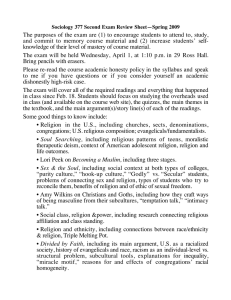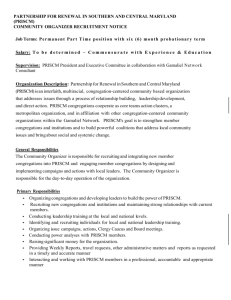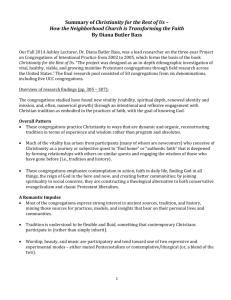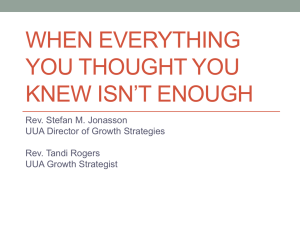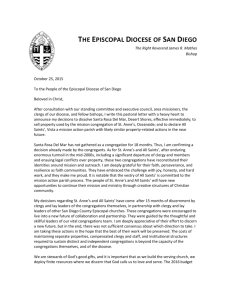Church-State Partnerships: Some Reflections from Washington, D.C.
advertisement
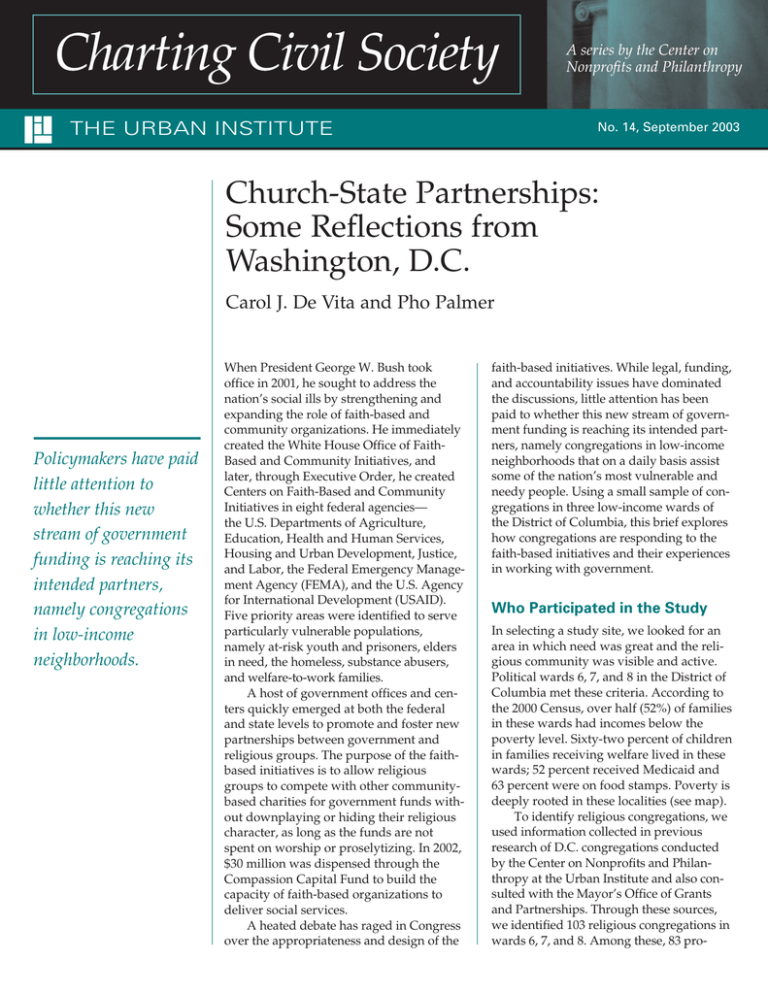
Charting Civil Society THE URBAN INSTITUTE A series by the Center on Nonprofits and Philanthropy No. 14, September 2003 Church-State Partnerships: Some Reflections from Washington, D.C. Carol J. De Vita and Pho Palmer Policymakers have paid little attention to whether this new stream of government funding is reaching its intended partners, namely congregations in low-income neighborhoods. When President George W. Bush took office in 2001, he sought to address the nation’s social ills by strengthening and expanding the role of faith-based and community organizations. He immediately created the White House Office of FaithBased and Community Initiatives, and later, through Executive Order, he created Centers on Faith-Based and Community Initiatives in eight federal agencies— the U.S. Departments of Agriculture, Education, Health and Human Services, Housing and Urban Development, Justice, and Labor, the Federal Emergency Management Agency (FEMA), and the U.S. Agency for International Development (USAID). Five priority areas were identified to serve particularly vulnerable populations, namely at-risk youth and prisoners, elders in need, the homeless, substance abusers, and welfare-to-work families. A host of government offices and centers quickly emerged at both the federal and state levels to promote and foster new partnerships between government and religious groups. The purpose of the faithbased initiatives is to allow religious groups to compete with other communitybased charities for government funds without downplaying or hiding their religious character, as long as the funds are not spent on worship or proselytizing. In 2002, $30 million was dispensed through the Compassion Capital Fund to build the capacity of faith-based organizations to deliver social services. A heated debate has raged in Congress over the appropriateness and design of the faith-based initiatives. While legal, funding, and accountability issues have dominated the discussions, little attention has been paid to whether this new stream of government funding is reaching its intended partners, namely congregations in low-income neighborhoods that on a daily basis assist some of the nation’s most vulnerable and needy people. Using a small sample of congregations in three low-income wards of the District of Columbia, this brief explores how congregations are responding to the faith-based initiatives and their experiences in working with government. Who Participated in the Study In selecting a study site, we looked for an area in which need was great and the religious community was visible and active. Political wards 6, 7, and 8 in the District of Columbia met these criteria. According to the 2000 Census, over half (52%) of families in these wards had incomes below the poverty level. Sixty-two percent of children in families receiving welfare lived in these wards; 52 percent received Medicaid and 63 percent were on food stamps. Poverty is deeply rooted in these localities (see map). To identify religious congregations, we used information collected in previous research of D.C. congregations conducted by the Center on Nonprofits and Philanthropy at the Urban Institute and also consulted with the Mayor’s Office of Grants and Partnerships. Through these sources, we identified 103 religious congregations in wards 6, 7, and 8. Among these, 83 pro- A series by the Center on Nonprofits and Philanthropy ASSESSING THE NEWSOCIETY FEDERALISM CHARTING CIVIL Reflections from the Community Religious Congregations in Low-Income Areas of Wards 6, 7, and 8 Ward 6 • • • • •• • • •• • • •• • • • • • • • • ••• •• • • • • • • ••• • Ward 8 • • • • • • • • • • •• • • •• •• •• • •• • • •• • •• • • • • •• • • •• • • •• • • • • • •• • Ward 7 • • • • • • • • •• • • • N To better understand the effects of faithbased initiatives in low-income communities, all participants were asked a series of open-ended questions regarding their opinions and impressions of the faith-based initiatives, their experiences working with government, their capacity to deliver needed services, and their ideas and recommendations to facilitate collaboration between religious congregations and government. Respondents expressed a wide variety of views on these subjects and gave their opinions in frank and open dialogue. Their responses are summarized below. • Religious congregations Anacostia river % of residents below poverty level <15% 15–30% 30–50% >50% vided complex social ministries or outreach programs such as after-school programs for youth, employment and training, substance abuse counseling, and assistance to families transitioning from welfare to work. Many of these congregations are located in the highest poverty areas of the city. Eighteen congregations were randomly selected to participate in the study and five agreed to be interviewed. We also held a focus group with eight pastors and clergy from the three wards who had participated in a workshop on faith-based grants conducted by the Mayor’s Office of Grants and Partnerships. This diverse group of 13 congregations ranged in size from small groups with about 100 members to very large churches with several thousand members. They represented many faiths—Baptist, Catholic, Methodist, and Muslim. All of these congregations, at some point in time, had sought government funding and were familiar with the grantmaking process, but only three had actually received government support for their social service programs. Reactions to the proposed faith-based initiatives were mixed. There was no consensus among the clergy in this study regarding the faith-based initiatives, although more were skeptical of the idea than embracing of it. One pastor called the initiatives “very exciting, long overdue, and wonderful.” Another said, “I’ll believe it when I see it. My history with government makes me cautious and skeptical.” The responses tended to be tempered by the size of the congregation, its denomination or affiliation, theological views, and past experiences with government, but because of the small size of the sample, we cannot reliably analyze the responses along these dimensions. A national study by Chaves (1999), however, found that larger congregations and “mainline” denominations are more likely than other groups to seek partnerships with government—a pattern that seems to be apparent in the comments of D.C. clergy. There was universal and emphatic agreement that working with government is complicated. Although opinions were mixed regarding the desirability of the proposed faith-based initiatives, there was unanimous agreement that it is difficult to work with government. Participants described their experiences as “bewildering,” “too much paperwork,” and “too much technical and bureaucratic jargon.” Larger congregations said that they worked with lawyers to write their grant applications and had legal counsel to negotiate their contracts. Smaller congregations with modest resources described how they collabo2 A series by the Center on Nonprofits and Philanthropy CHARTING CIVIL SOCIETY “We need to invest in our people [both staff and residents] by giving them education and training.” rated with one another and hired grant writers to assist them with their applications. Those who were unsuccessful expressed disappointment and sometimes anger at the time and resources consumed in these “wasted efforts.” Many of these local clergy viewed the faith-based initiatives as just another government program that comes with a top-down style of management rather than one that works with community and religious leaders to identify needs and develop appropriate approaches for addressing these needs. Staffing constraints and infrastructure limitations make it difficult for smaller congregations in low-income areas to partner with government. Repeatedly, the stories that were told suggested that a congregation’s size is a good proxy for capacity and resources, but that these characteristics alone do not tell the whole story. Take for example food programs. One church with 300 members operates a food pantry run by three volunteers who distribute bags of groceries to 35 to 50 families once each month. Another church with only 100 members operates a meal program in its fellowship hall providing lunch five days a week for 90 to 125 people daily. The personal commitment of the congregation members can make a critical difference (see sidebar). Nonetheless, clergy said that it was relatively easy to recruit and retain volunteers for simple tasks such as food programs, but that it often takes paid professional staff to run complex programs like the ones targeted by the White House faith-based initiatives. Larger congregations or congregations affiliated with service structures such as Catholic Charities or Lutheran Social Services tend to have a built-in advantage in providing these services because they have structures to guide them, to help secure resources, and to expand local capacity. Small and unaffiliated congregations can be at a disadvantage when it comes to mustering the wherewithal to partner with government. Current levels of technical assistance need to be expanded. Efforts to provide technical assistance to local congregations were seen as necessary but not sufficient by these local clergy. Many congregations need help not only in identifying funding opportunities and writing proposals, but also during program implementation. Nearly all of the clergy in the study had attended one or more of the workshops that federal agencies or the Mayor’s office sponsored to inform and advise faith-based groups on funding opportunities. However, many clergy viewed the grantmaking process as highly political and sometimes questioned the fairness of the funding decisions. One respondent said, “After a few meetings, I stopped going. I heard the same old stuff. It’s not about helping the people. People were jockeying for positions.” Another said, “If my card is not in your rolodex, how do you know that I’m doing good work?” And a third added, “It takes the heart out of good people who are trying to do the right thing.” On the other hand, some pastors were less skeptical of the selection process and more concerned with the need for technical assistance during implementation. They felt that technical assistance would be necessary to help them meet contract requirements, set up reporting systems, and handle financial accounting. These clergy recognized that winning the contract was only half the battle. What is needed most: money. Repeatedly, clergy from low-income neighborhoods stated that what they needed most for their programs was money. So little money has been appropriated to date for faith-based initiatives that it has fueled skepticism and disenchantment. Typical comments were “There’s no real money [behind this issue].” “There’s no new money.” “$30 million for the entire United States is not a commitment. . . . It’s a joke.” While money can help fund the actual program operations, many clergy recognized that sustaining a well run, complex program requires more than good-hearted volunteers. Several clergy explained that money was essential to operate a quality program. “Money makes it possible to have dedicated staff and make people feel valued.” Another replied, “We need to invest in our people [both staff and residents] by giving them education and training” to do these jobs. Many clergy in the study said that they saw few tangible benefits reaching lowincome communities and needy residents. They feared that funding would 3 A series by the Center on Nonprofits and Philanthropy CHARTING CIVIL SOCIETY Contracts versus Collaborations T here are many ways in which local congregations can partner with government and address important needs in their communities—some of these are formal grants and contracts, collaborations, and voucher programs. Each of these mechanisms has its own strengths and weaknesses, but they are the principal structures by which government and the faith community are likely to interact. Vouchers are being used more frequently in the social service delivery system, but the traditional arrangement has been through formal contracts and informal collaborations with government. Several congregations in this study discussed their experiences with these arrangements. Two churches in our study had received grants from government and spoke at length about their experiences. One very large church with several thousand members received a $100,000 grant to run an after-school program for youth. Despite considerable and valued technical assistance from the funding agency, the project was underfunded and the congregation ended up paying $50,000 from its own money to complete the project. A small congregation with a few hundred members received a $15,000 grant for a job-training program. It, too, received technical assistance, but the congregation had to hire additional staff and consultants to meet the contract requirements and paid a $7,000 cost overrun from church coffers. Both congregations said that they were thrilled to get the awards and eager to provide a needed social service in their neigh- be siphoned off by intermediary organizations or congregations located outside poor neighborhoods. Recommendations from Clergy When asked what could be done to make the new faith-based initiatives work borhoods, but both also said that they were not fully prepared to work with government. The large congregation said that it would continue to offer its youth program and to work with government, but it would raise additional private money to supplement government funds and ensure a quality program for youth in the neighborhood. The small congregation described its effort as “a mistake,” and plans to discontinue its employment and training program, return to its traditional food ministries, and not seek government funds in the future. Although both congregations had similar experiences, the larger body has more built-in capacity and financial reserve to sort through contractual difficulties, supplement inadequate amounts of government funding, and continue working with government. Other D.C. congregations have formed collaborative partnerships with government that draw on the congregations’ strength—volunteer labor. Rather than monetary exchanges, several local churches supply volunteer labor for governmentfunded programs. One pastor described how his congregation joined with other churches in the area to work with a Meals-on-Wheels program, supplying the volunteer labor to deliver hot meals to needy residents. Each church supplies volunteers one day per week, thereby sharing the tasks without burdening any one congregation. These types of arrangements enable smaller congregations with limited capacity to work with government and address important community needs. more effectively, local clergy had three recommendations: Earmark new money to small congregations in low-income areas. If the faith-based initiatives are to reach their intended audiences, then these clergy felt that money should be specifically directed to areas where the need was the greatest. 4 CHARTING CIVIL SOCIETY Improve coordination of technical assistance workshops so that every government agency is not saying and doing the same thing. The proliferation of workshops was viewed as a wasteful duplication of effort and a timeconsuming drain for local clergy. One respondent suggested that the workshops might be designed to confer a “pre-approval” status on attendees—that is, if clergy attended the meetings, they would be entitled to follow a simplified application process. Create incentives to stimulate volunteering. Because many of these programs use volunteers to deliver services, respondents suggested that a tax credit or tax deduction be given for time spent in volunteer activities. This might encourage more people to volunteer and reward individuals who give their time. Policy Implications Stepping back from the intensity of these local perspectives, what broader policy implications can be gleaned from these findings? At least three areas are apparent. First, the political fanfare that preceded the unveiling of the faithbased initiatives has not been matched with a monetary commitment to this effort. The small pool of money that has been issued to date has fueled skepticism and disenchantment among many clergy who are only too aware that a serious government commitment to support and enhance their work requires much more money. Enlarging the eligibility pool of applicants without increasing available funds breeds more competition but will not necessarily increase results. Small houses of worship and those in economically poor areas are likely to be at a disadvantage in this more competitive arena despite attempts by government agencies to level the playing field. A series by the Center on Nonprofits and Philanthropy Second, implementation issues are barely being addressed by government agencies. Streamlining the application process, perhaps through better use of the new federal government unified e-grant system, is one step, but much more will be required. Faith-based providers, particularly congregations, will need to be guided through the entire grant process—identifying funding opportunities, writing proposals, negotiating contracts, setting up client tracking and monitoring systems, developing reporting standards, measuring outcomes, and maintaining financial accounts. Rather than a one-size-fits-all, top-down system of grant administration, government agencies will need to create mechanisms for technical assistance, feedback, and monitoring that can be adapted to varying levels of organizational capacity and sophistication. To do this will take time, money, and a reorientation of government agency staff. Finally, policymakers need to better define the appropriate boundaries between sacred and secular. When does program content cross the line between inspiring and proselytizing? Can hiring practices in some faith communities be reconciled with civil rights and anti-discrimination laws? As one clergy noted, “The interests of the two sides [secular and sacred] differ. The secular should be nondiscriminatory and interfaith. The sacred side is God’s work. We don’t want to change our ways.” Without some guidelines, policymakers are inviting a rash of lawsuits that will clog the courts and deflect energy from helping the needy. The gap between political rhetoric and community reality is great, but the faith-based initiatives provide a new opportunity for government to work with local communities, identify and address their needs, strengthen community capacity, and empower local residents. Local clergy in low-income neighborhoods can be a vital force in this process if given a chance to be heard. There are clearly many barriers to overcome, but greater attention to implementation issues, including the capacity of local congregations to provide services, is needed to create church-state partnerships that might benefit local communities and people in need. Reference Chaves, Mark. 1999. “Congregations’ Social Service Activities.” Washington, D.C.: The Urban Institute. Charting Civil Society Policy Brief No. 6. Carol J. De Vita, a senior research associate in the Urban Institute’s Center on Nonprofits and Philanthropy, studies the role, capacity, and networks of nonprofit organizations in local communities. The work has a special focus on faith-based groups and their ability to provide needed services, particularly in low-income neighborhoods. Also see, “Faithbased Initiatives: Sacred Deeds and Secular Dollars” by Dr. De Vita and Sarah Wilson, a policy brief prepared for the Urban Institute-Hauser Center for Nonprofit Organizations seminar series, Emerging Issues in Philanthropy, May 2001. Pho Palmer is a project associate with the Center on Nonprofits and Philanthropy at the Urban Institute. Ms. Palmer conducts research on the role and capacity of religious congregations in three low-income wards in the District of Columbia, and their experiences with Charitable Choice. 5 THE URBAN INSTITUTE 2100 M Street, NW Washington, DC 20037 Nonprofit Org. U.S. Postage PAID Permit No. 8098 Mt. Airy, MD Address Service Requested For more information, call Public Affairs: 202-261-5709 or visit our web site, http://www.urban.org. To order additional copies of this publication, call: 202-261-5687 or visit our online bookstore: http://www.uipress.org. The Urban Institute’s Center on Nonprofits and Philanthropy (CNP) was established in September 1996 to explore the role and contributions of nonprofit organizations in democratic societies. The work of CNP will be communicated through the dissemination of timely, nonpartisan research to policymakers, practitioners, researchers, the media, and the general public. The National Center for Charitable Statistics (NCCS) became a part of the Urban Institute in July 1996 and is the statistical arm of the CNP. The mission of NCCS is to build compatible national, state, and regional databases and to develop uniform standards for reporting on the activities of charitable organizations. NCCS databases are available on CD-ROM, diskette, 9-track tape, or via File Transfer Protocol (FTP) in a variety of database formats. For information, call 202-261-5801 or visit our web site, http://cnp.urban.org/. THE URBAN INSTITUTE 2100 M Street, NW Washington, DC 20037 Copyright © 2003 Phone: 202-833-7200 Fax: 202-467-5775 E-mail: pubs@ui.urban.org The views expressed here are those of the authors and do not necessarily reflect those of the Urban Institute, its board, its sponsors, or other authors in the series. Permission is granted for reproduction of this document with attribution to the Urban Institute.

